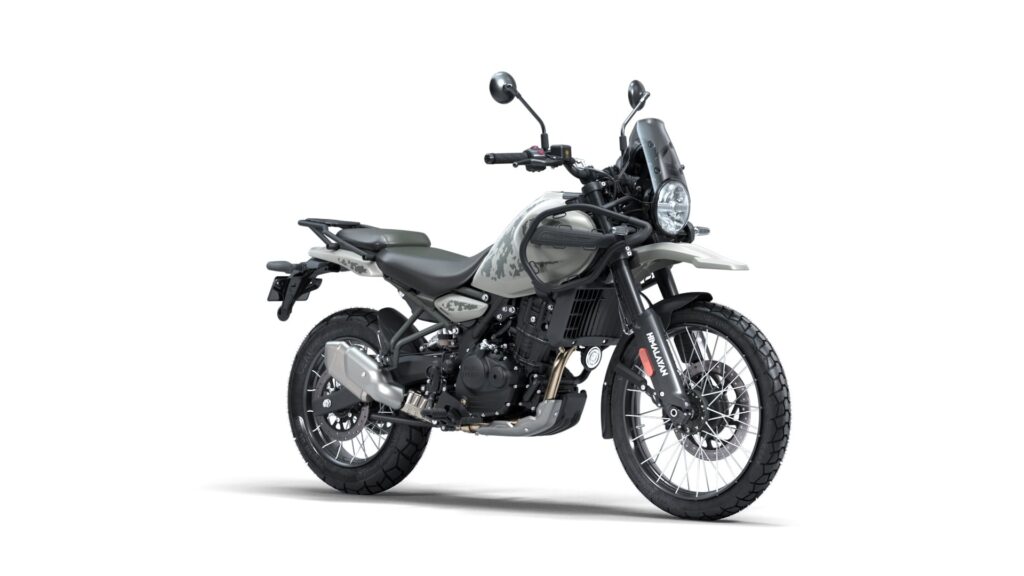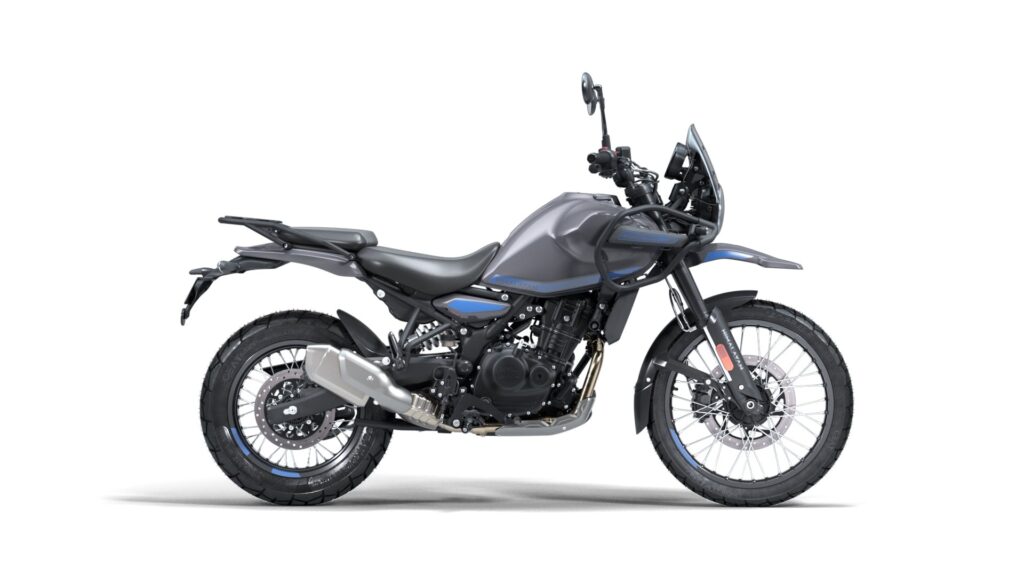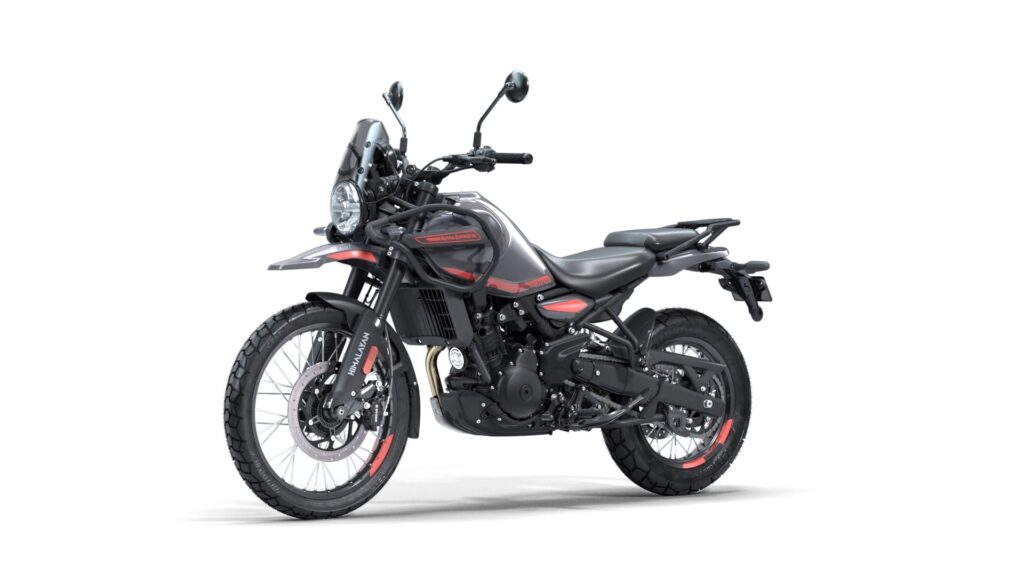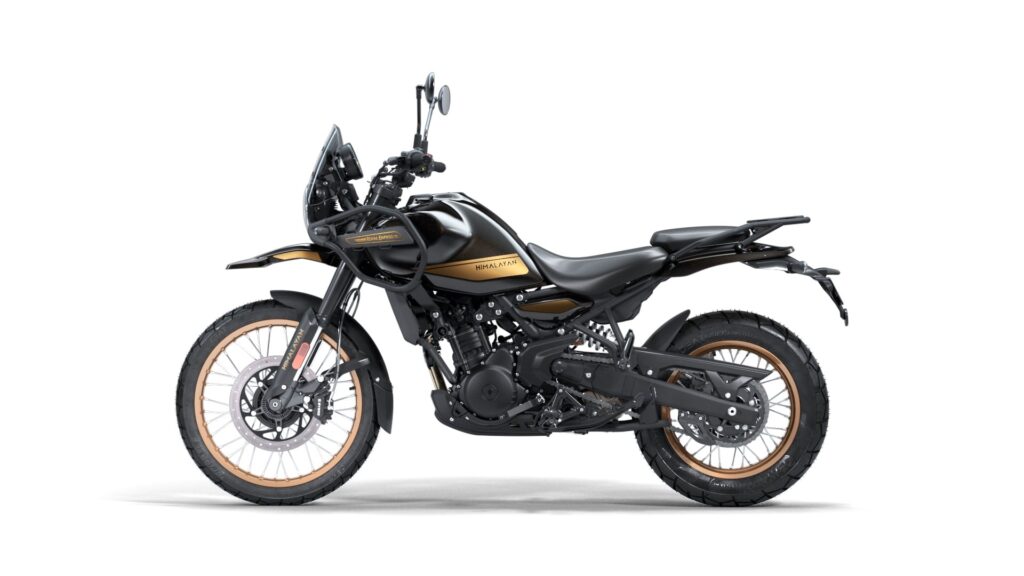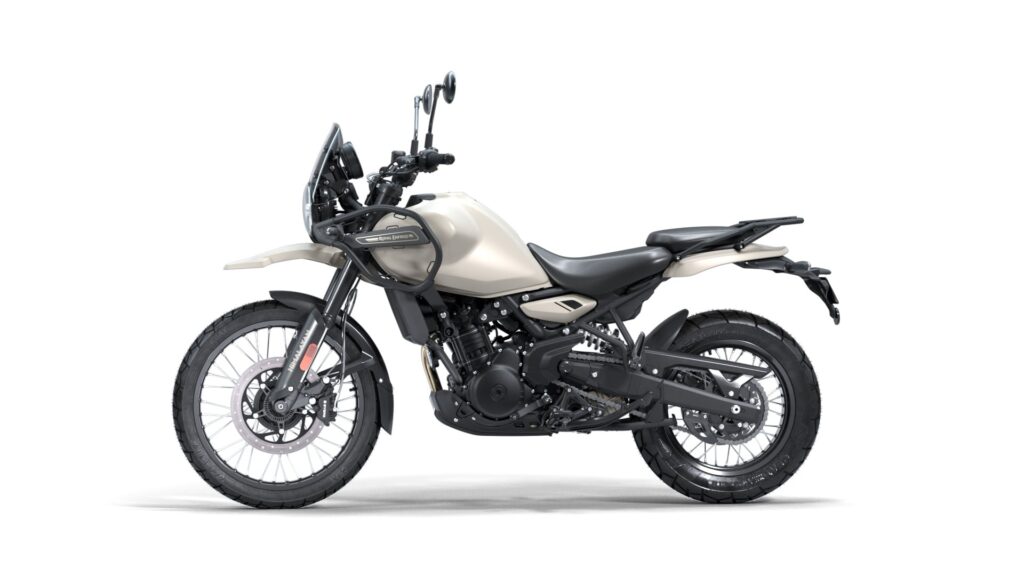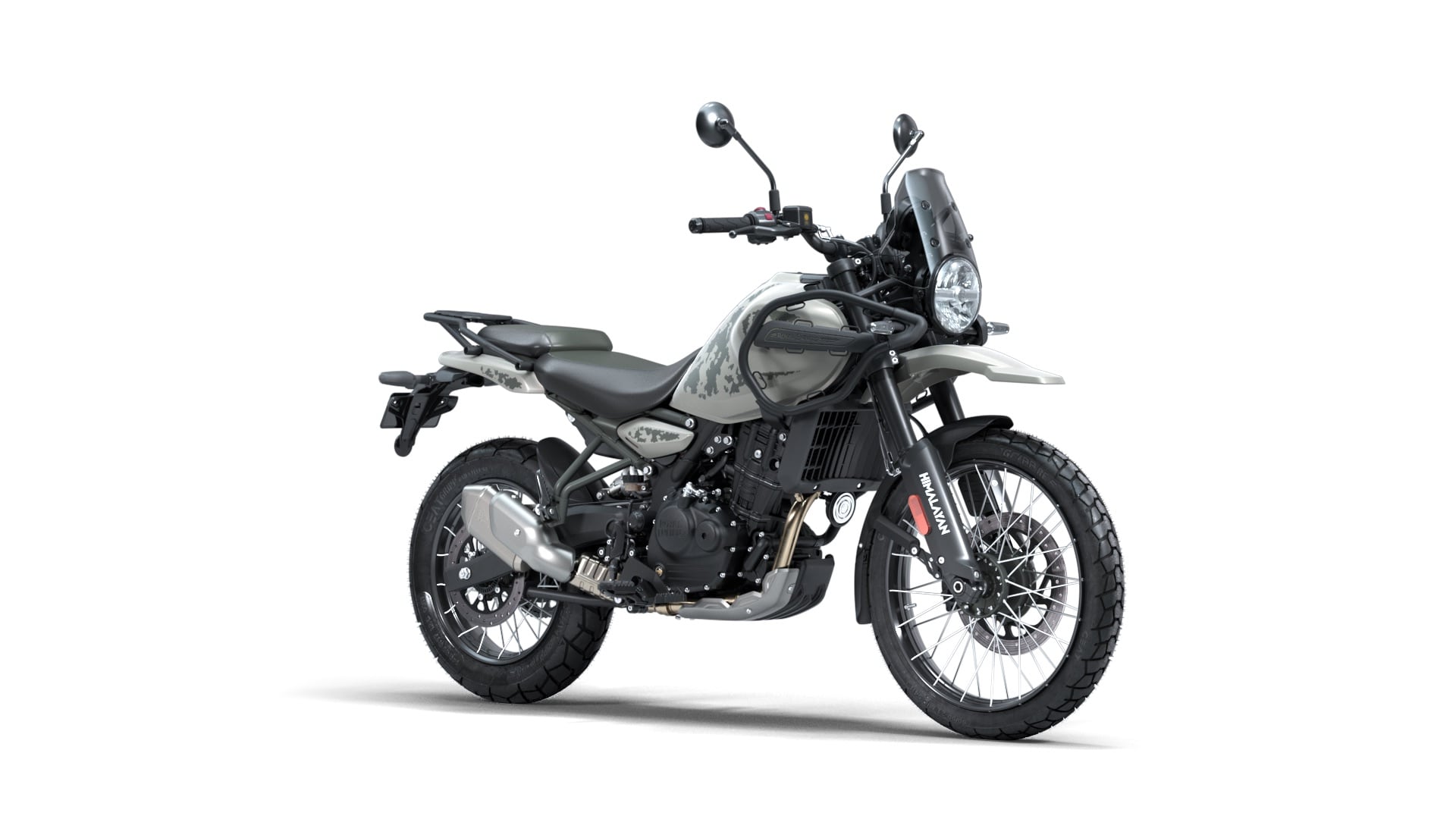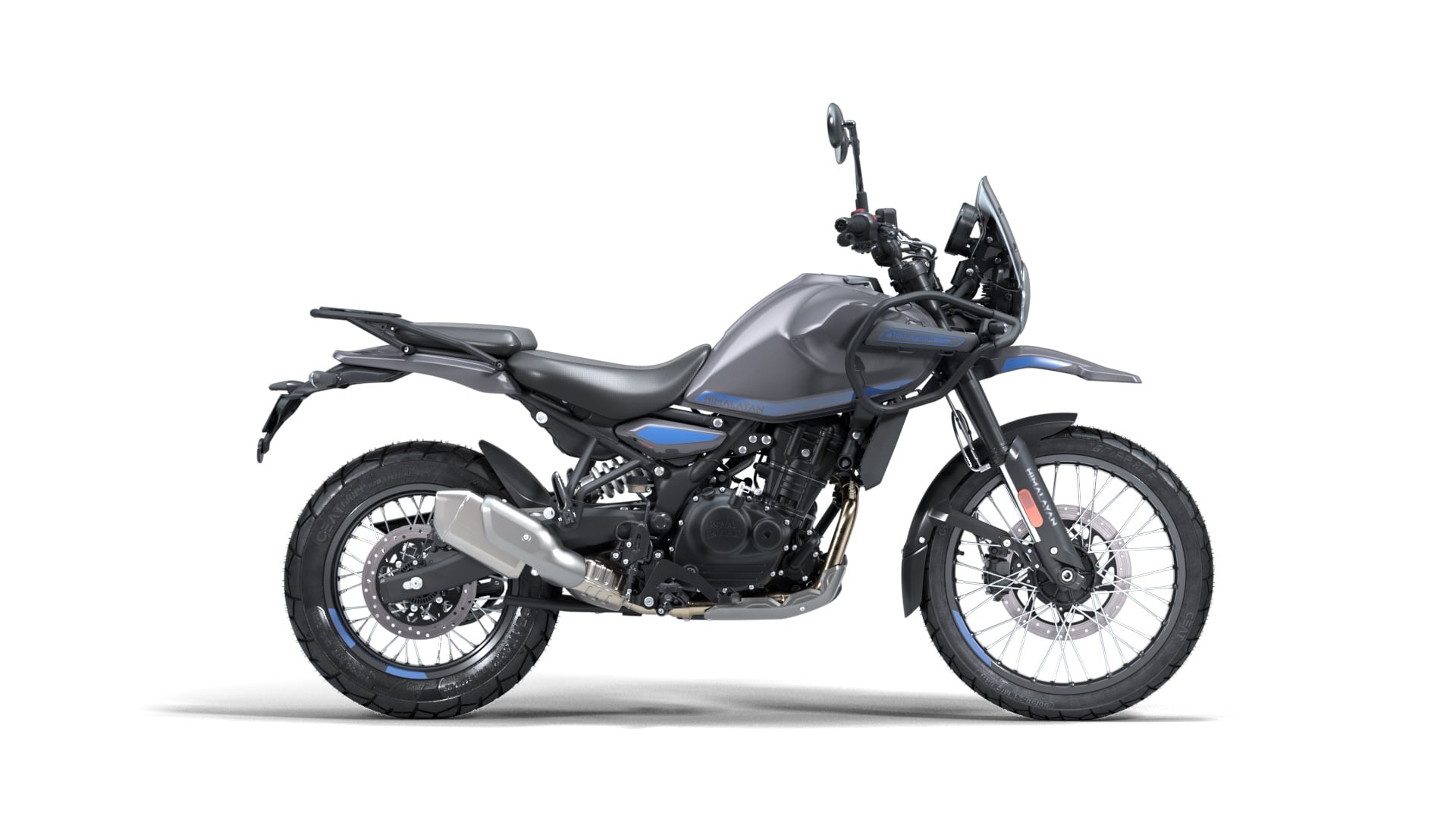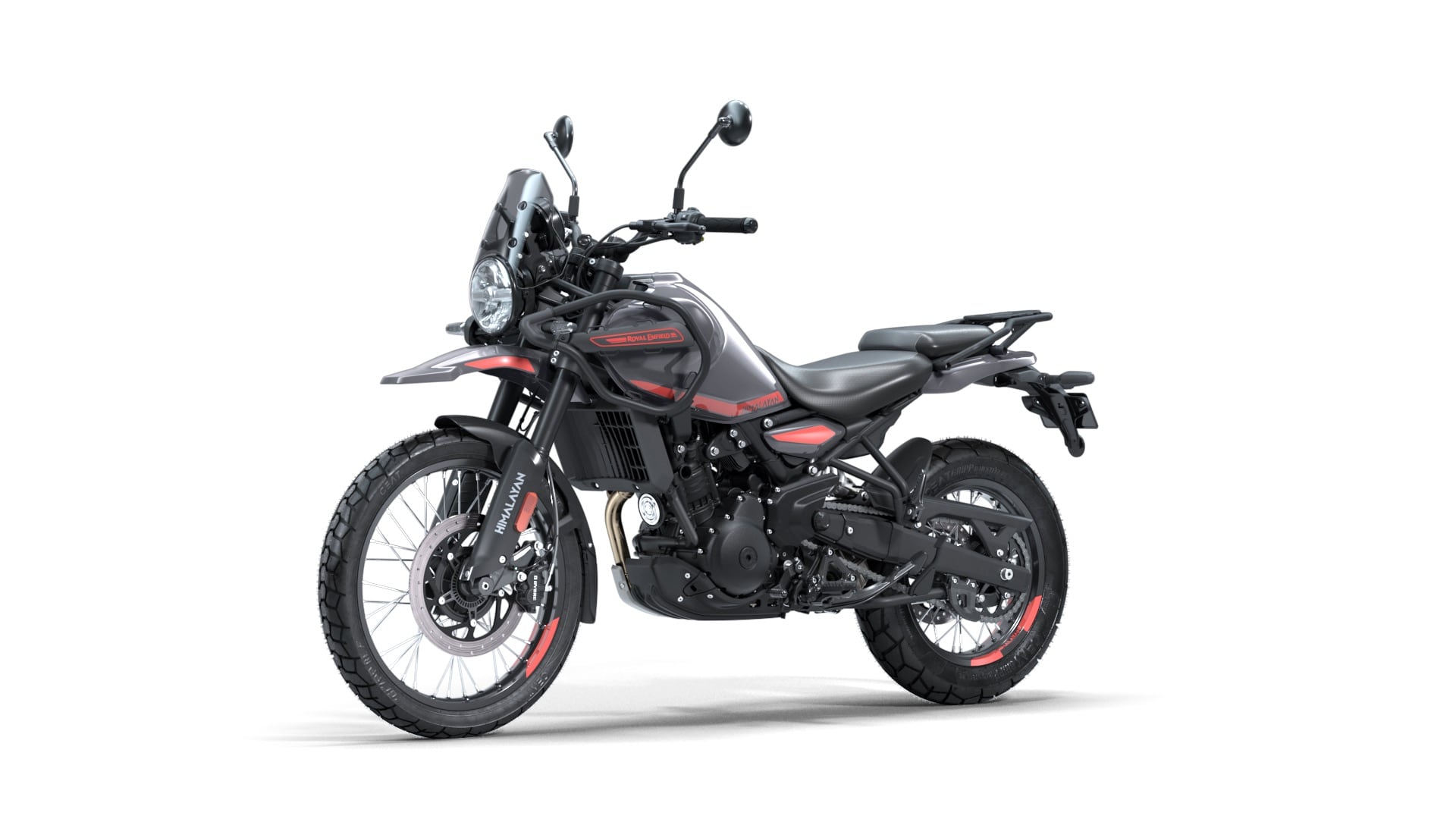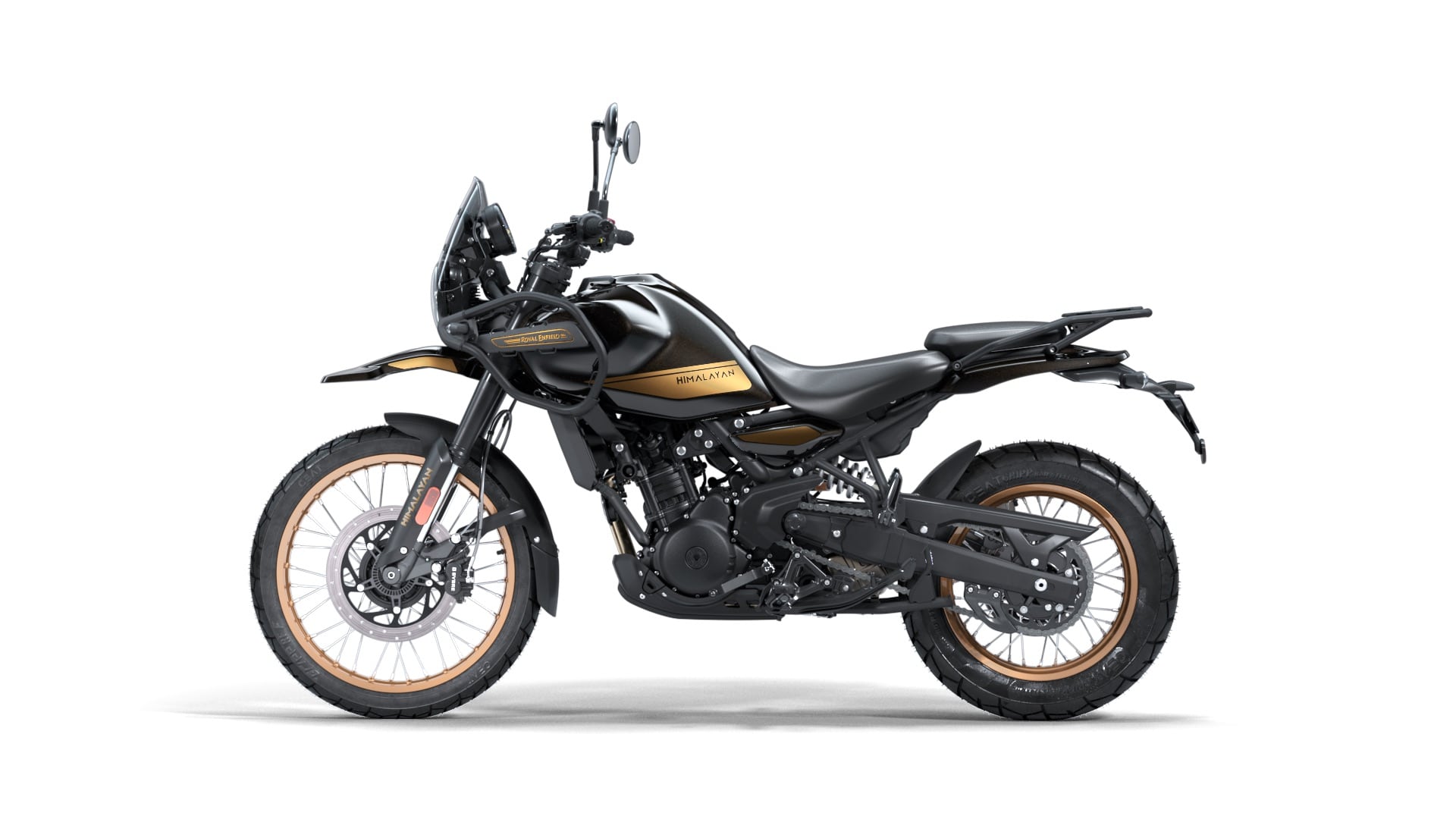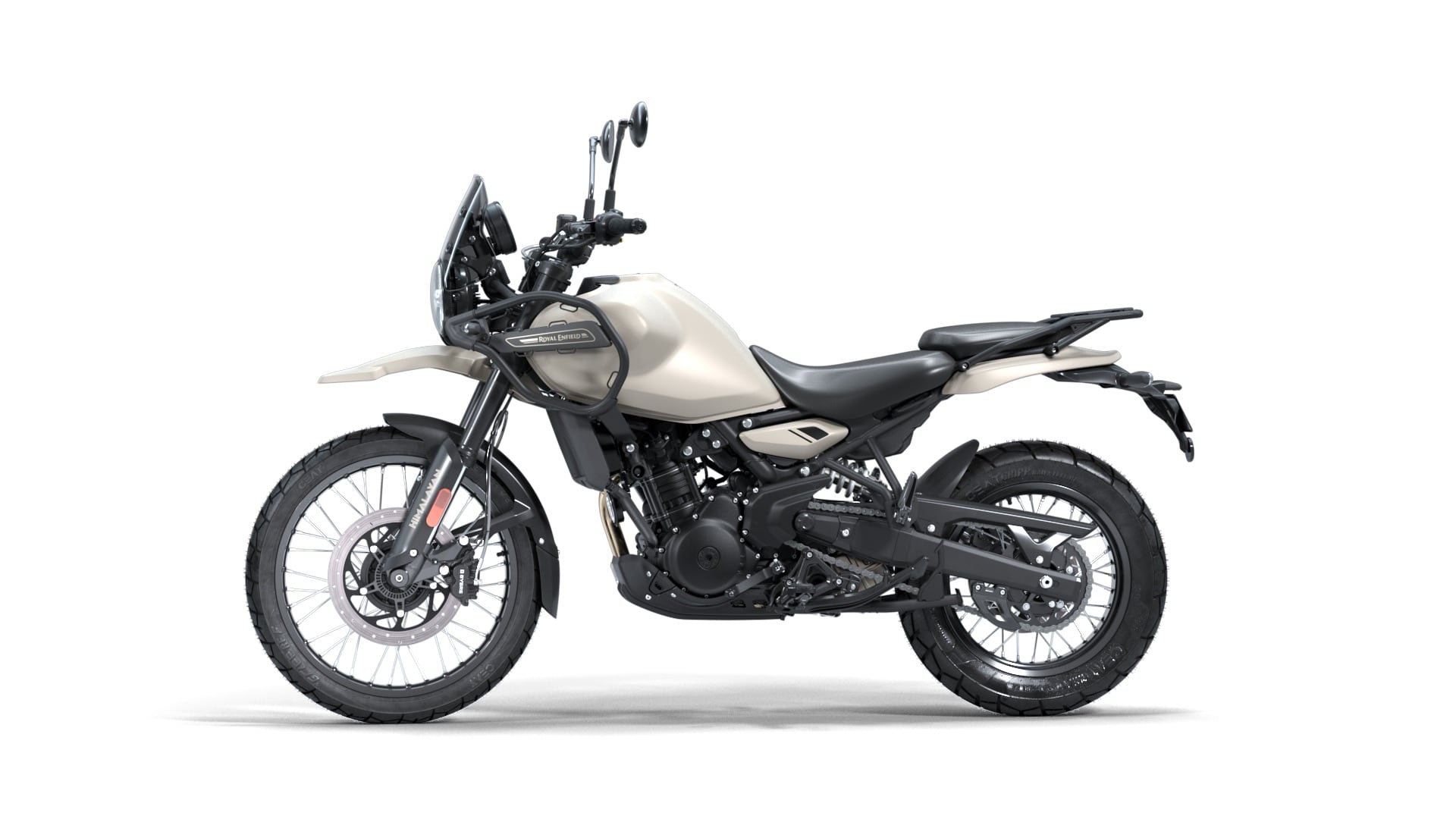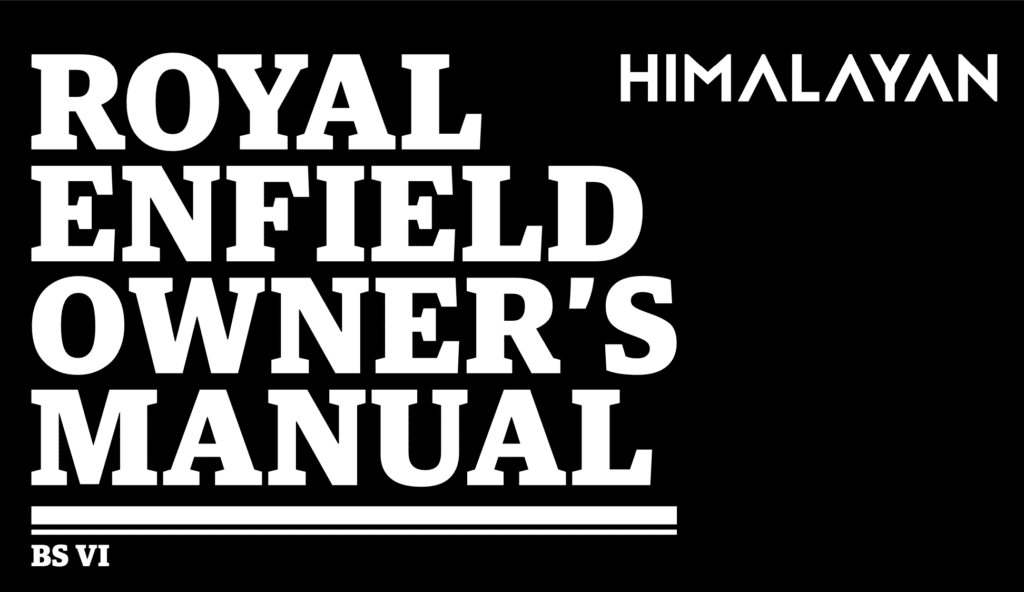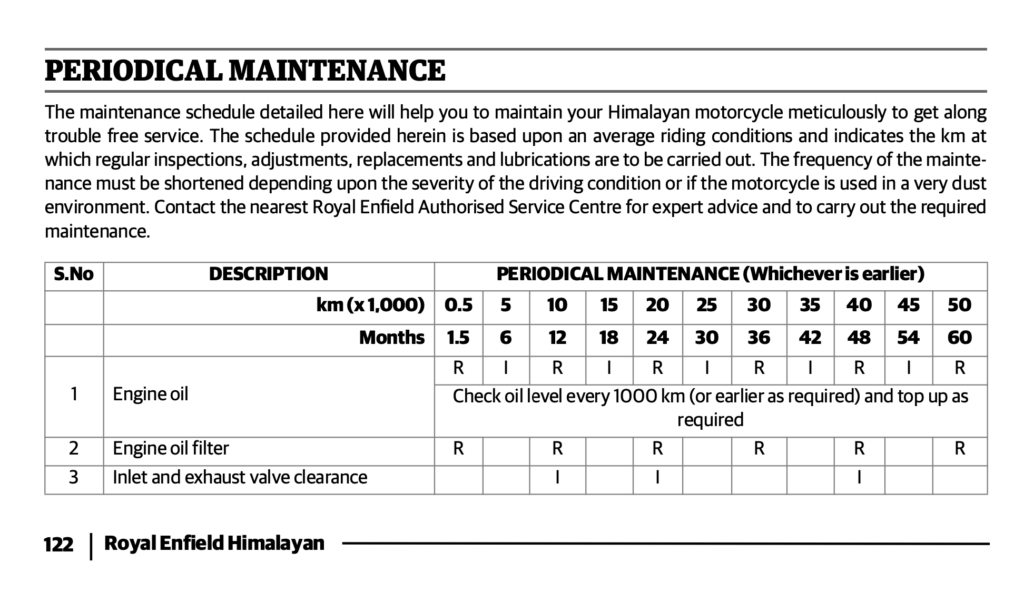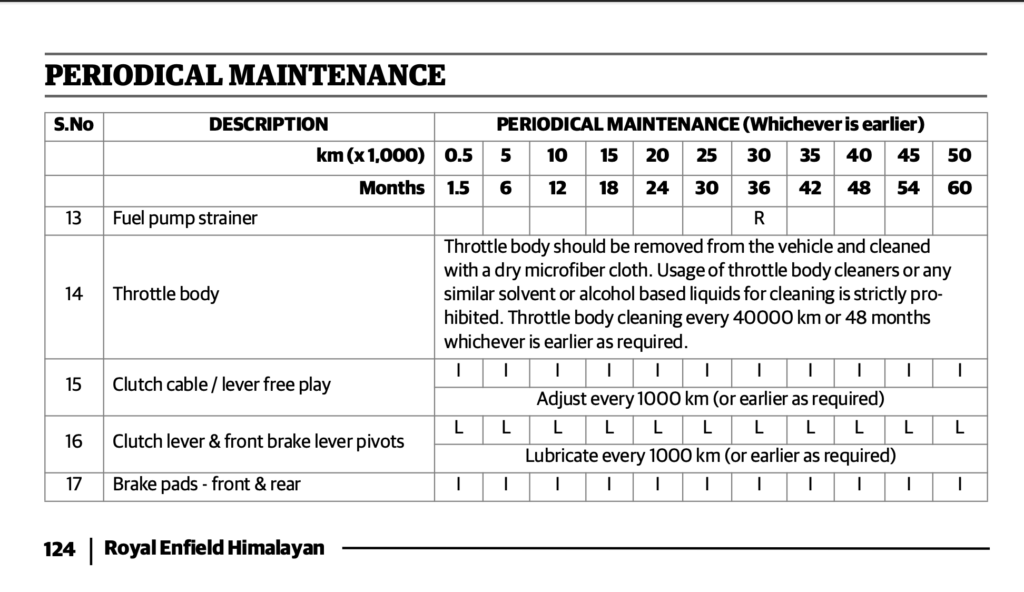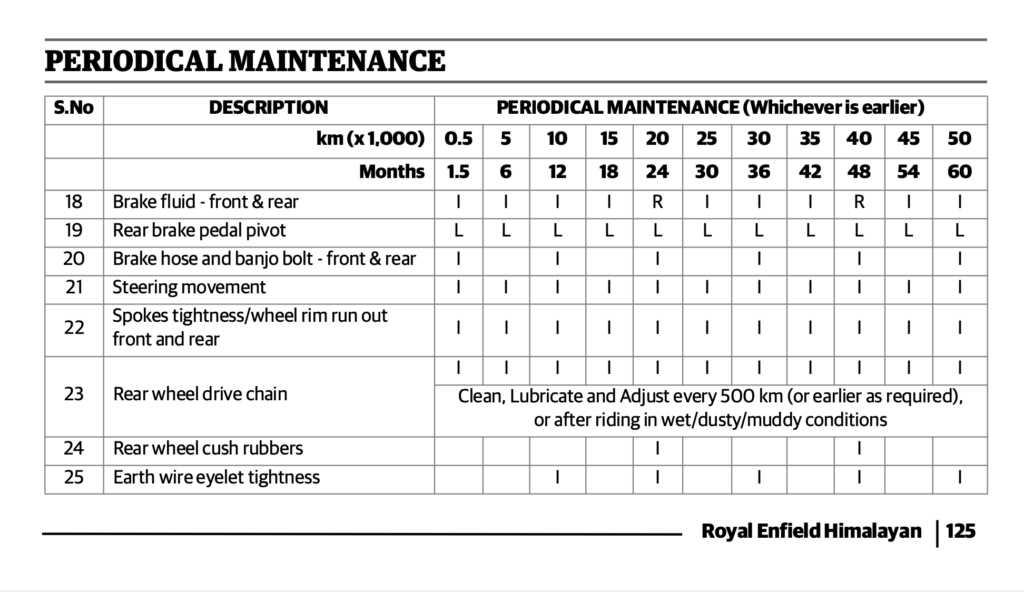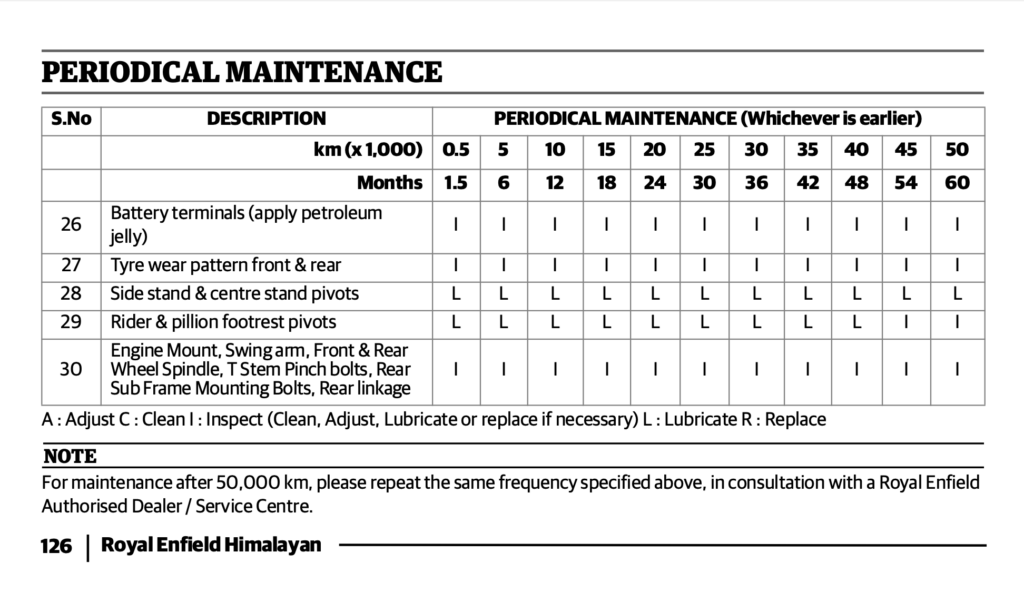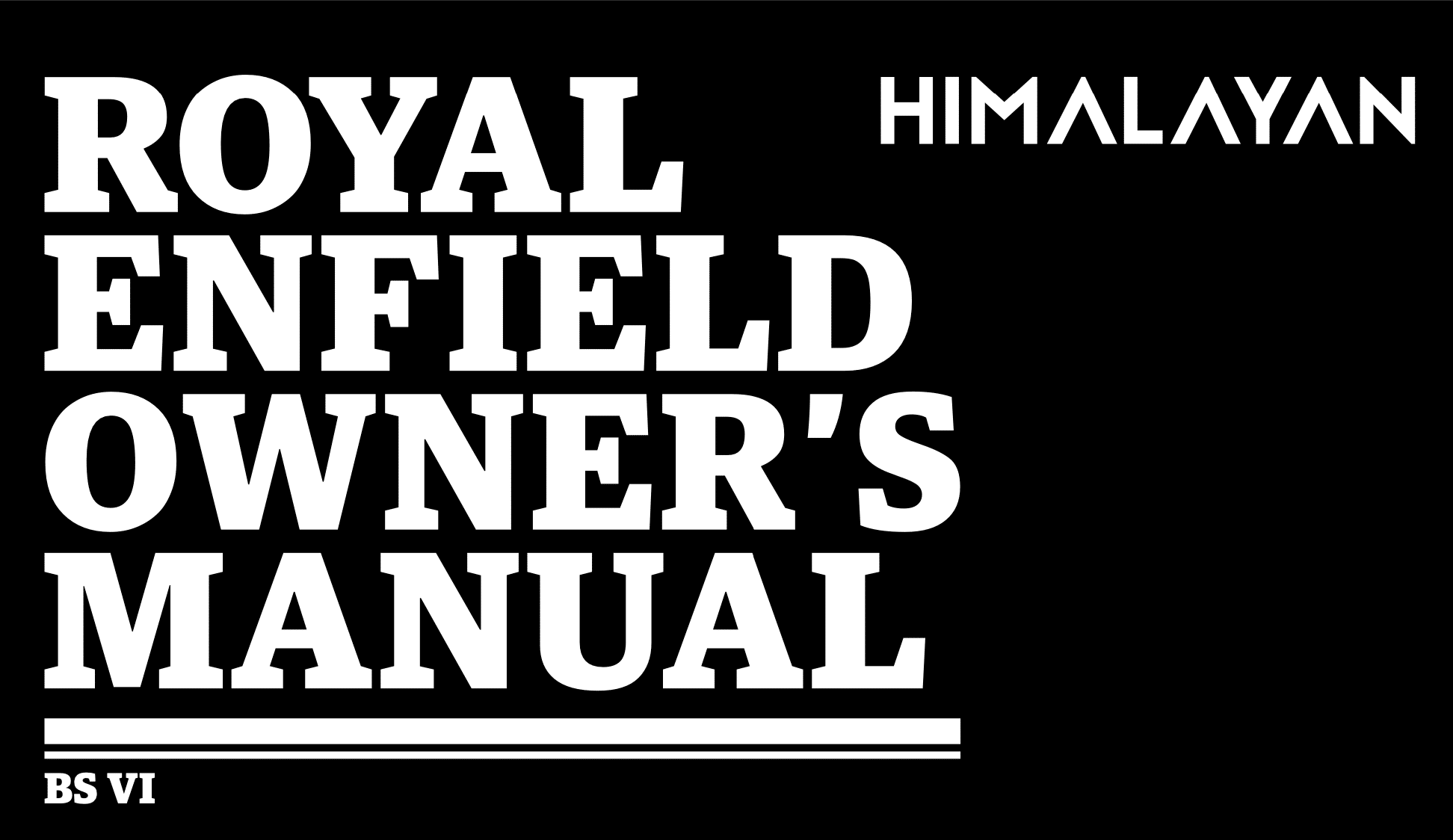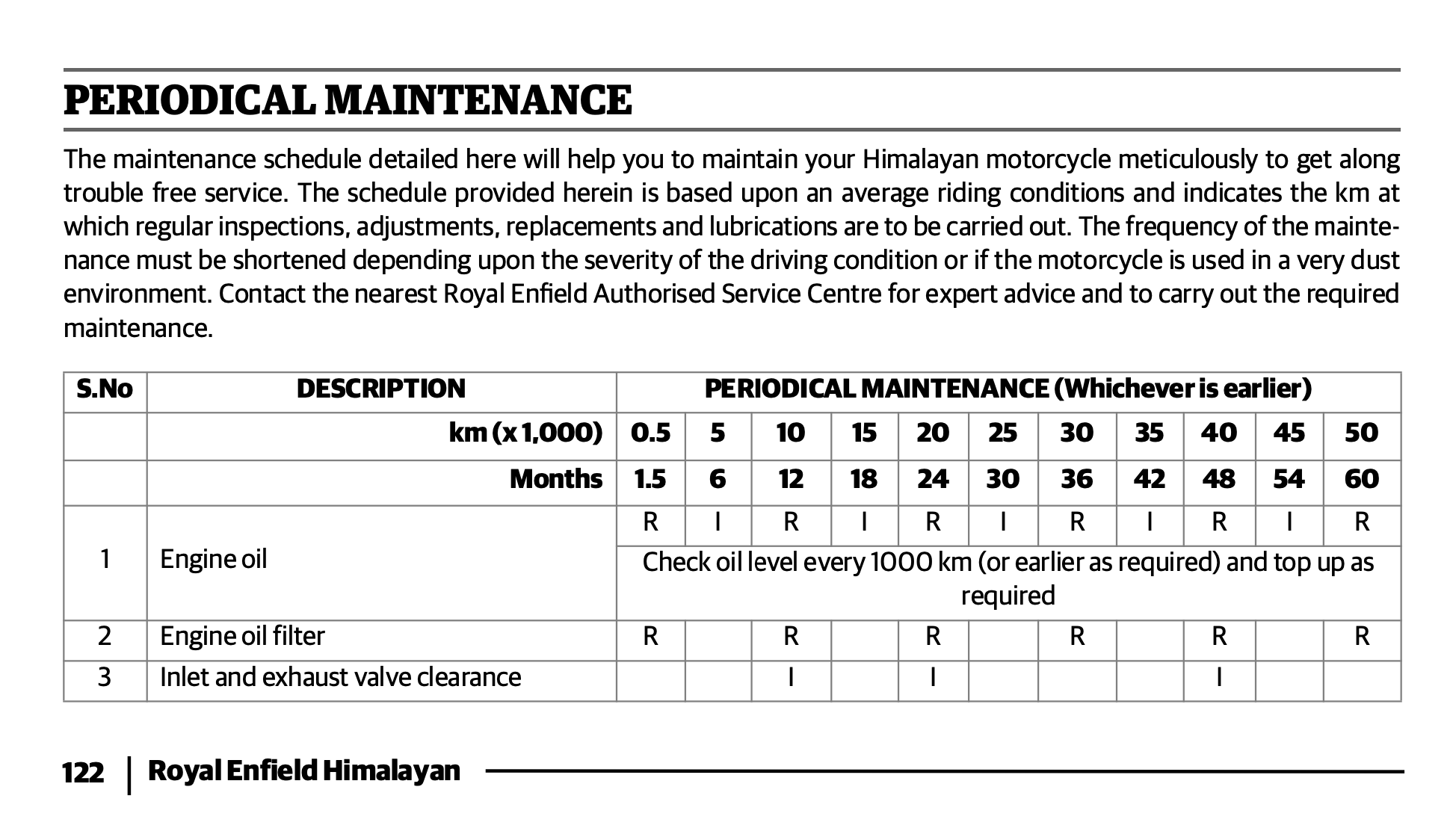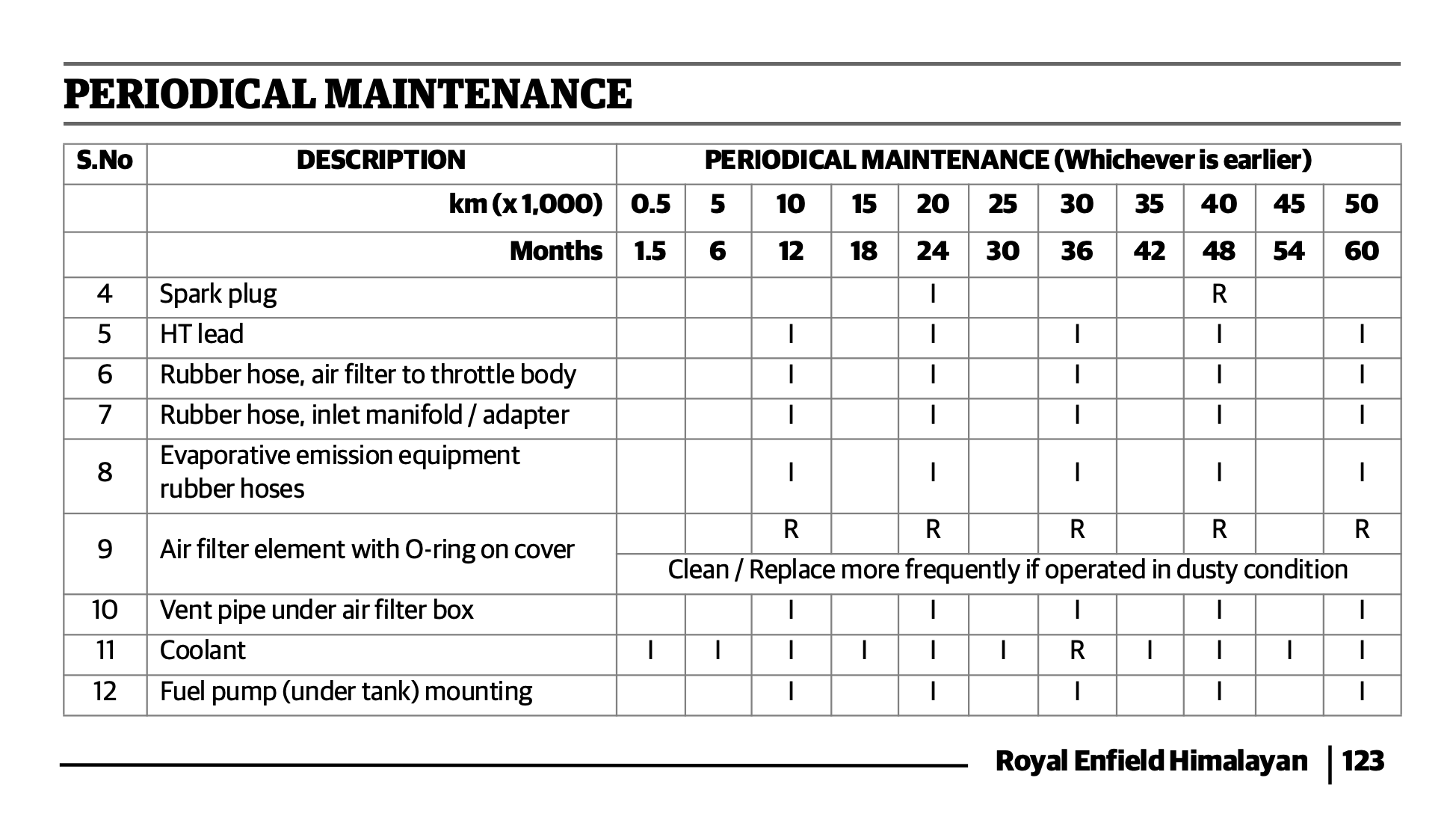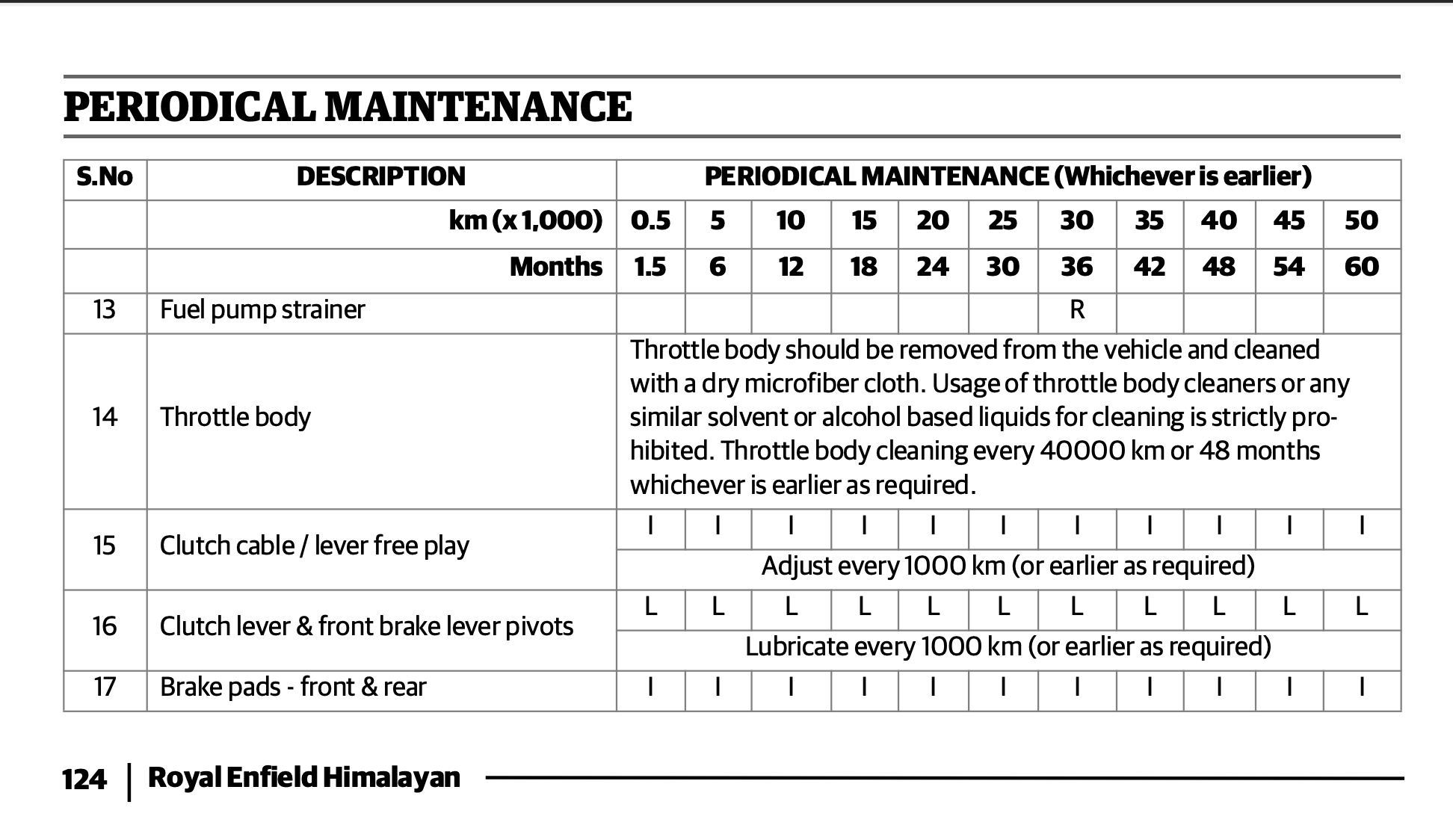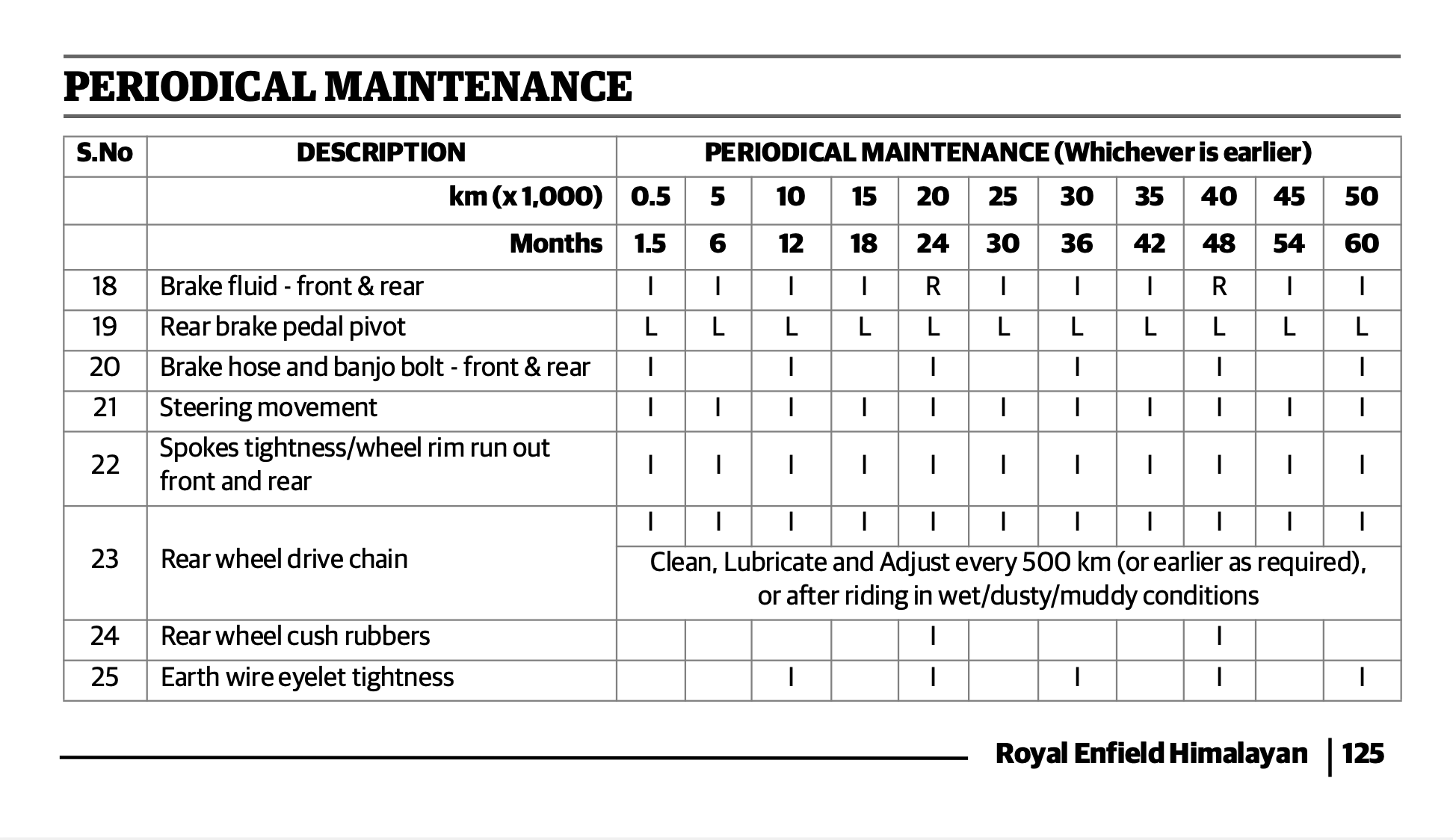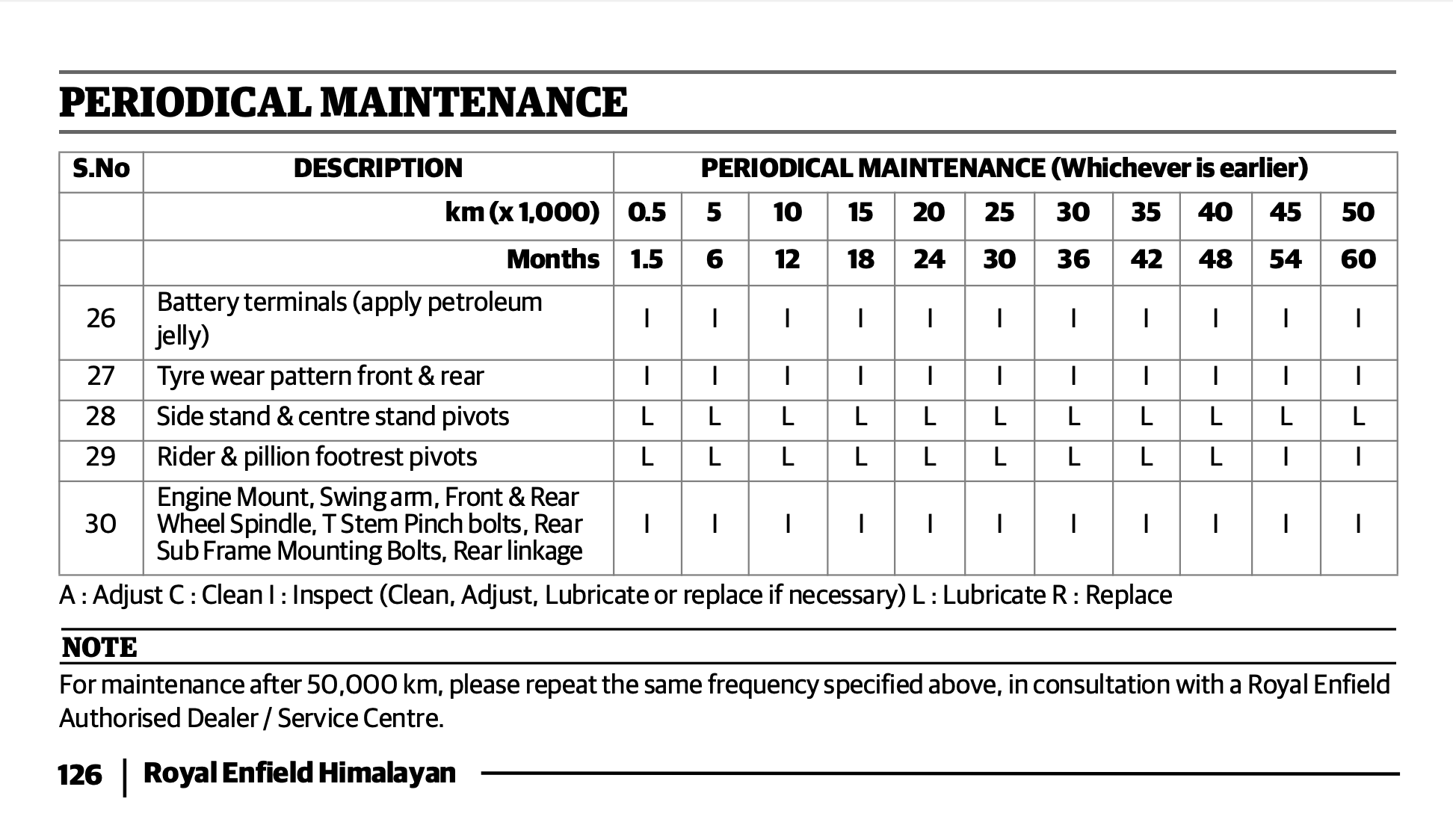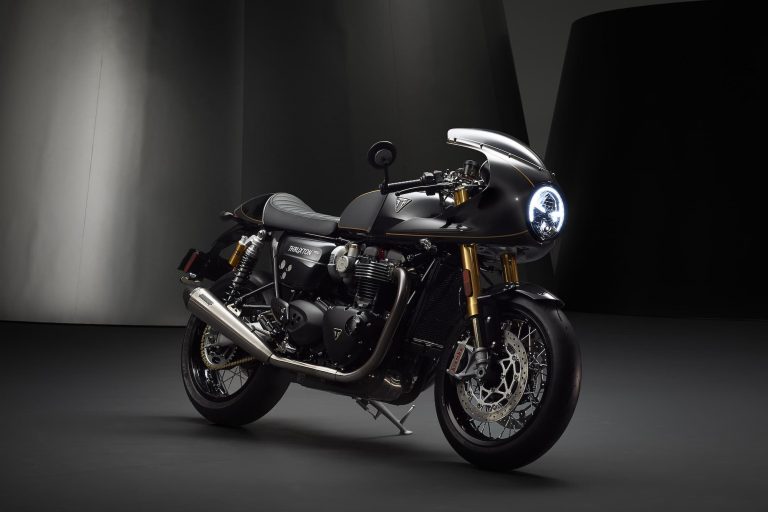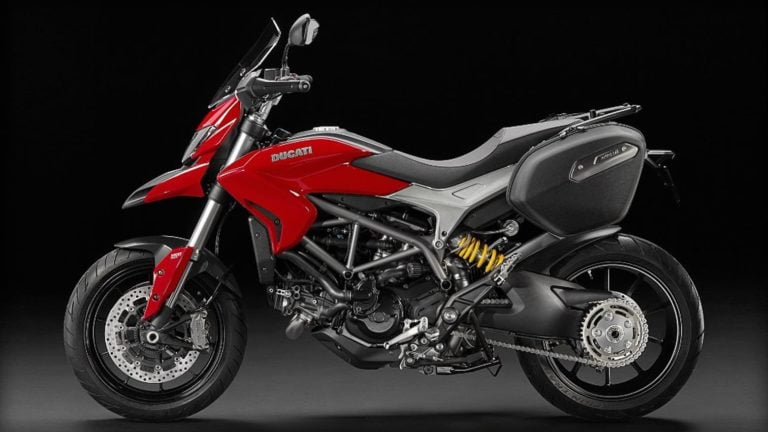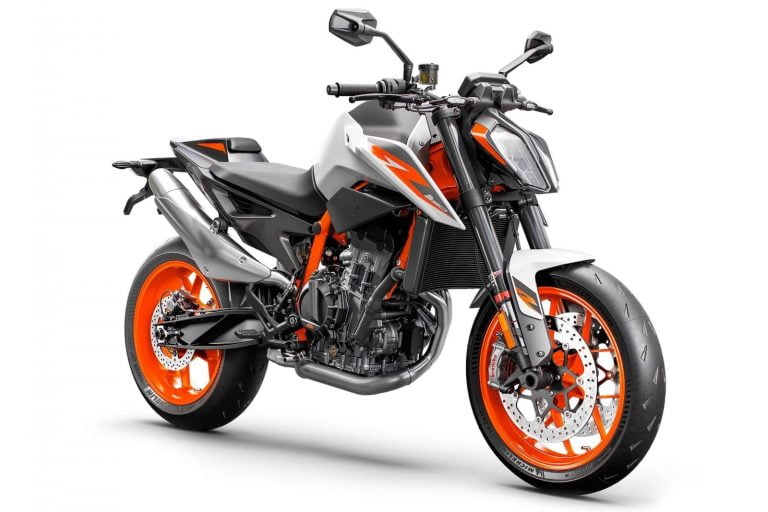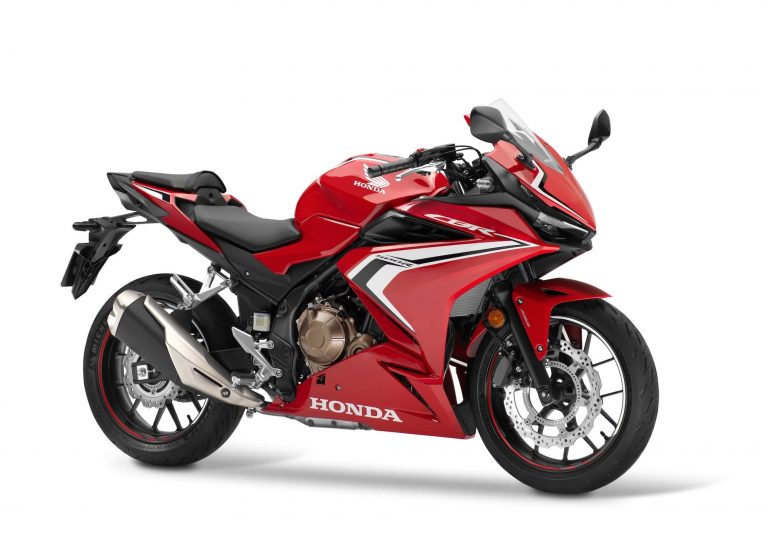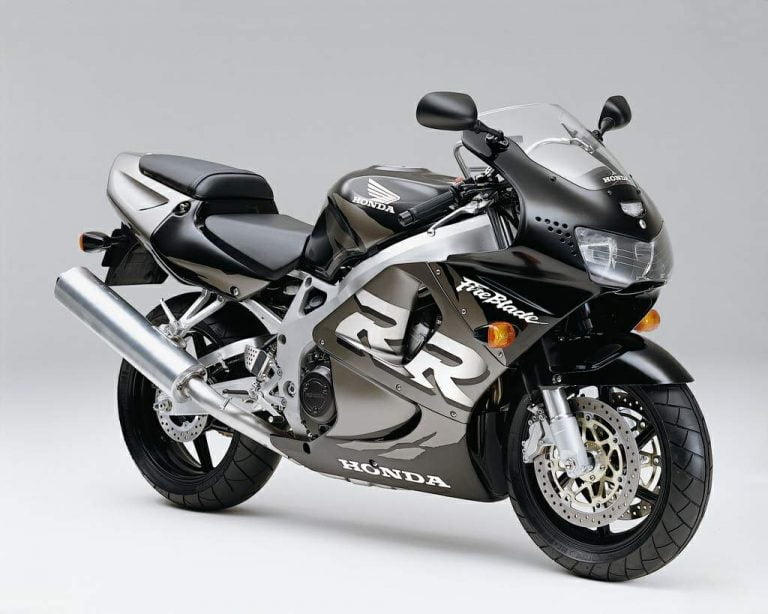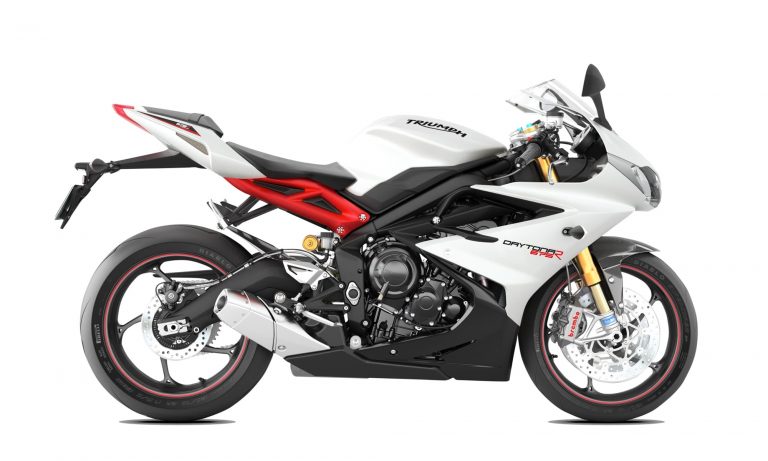Royal Enfield Himalayan 450 (2024+ 2nd gen) Maintenance Schedule
This is the maintenance schedule and service interval information for the 2nd generation Royal Enfield Himalayan. Royal Enfield calls it the “new” Himalayan, but we’ll call it the Himalayan 450 for simplicity.
The Royal Enfield Himalayan 450 is a complete overhaul of the original Royal Enfield Himalayan. Like the original bike, it’s still a compact adventure motorcycle based on a single-cylinder engine, but the new engine has more displacement, is liquid-cooled, has four valves, and makes quite a lot more power. Still not a lot, but quite a lot more.
Final drive is via a six-speed transmission (up one from five) and chain.
This site has links from which we earn a commission (which unfortunately nobody can save, not even us). If you appreciate this research work, then please use those links. Thanks.
Royal Enfield Himalayan 450 Service Intervals
Overall, the Himalayan 450 has required 6,000 mile / 10,000 km or annual service intervals worldwide. At every service, change the oil and filter and do a host of other checks specified below.
In the US, Royal Enfield also recommends you do the service checklist every 3,000 miles / 5,000 km or six months for the Himalayan 450. But this is absent from the UK / Europe manual.
The major valve inspection is every 6,000 miles / 10,000 km for the first two services, but this spaces out to every 12,000 miles / 20,000 km after the second service.
Because the 2024 Royal Enfield Himalayan 450 has a liquid-cooled engine (the LS450), you do need to check the coolant level and to replace the coolant every 24,000 miles / 36,000 km or 3 years.
Finally, make sure you regularly maintain the chain, especially if riding off-road, where the Himalayan thrives.
Maintenance Schedule for the Royal Enfield Himalayan 450
Below is the maintenance information for the Himalayan 450 from the owner’s manual.
We’ve reformatted it slightly for ease of reading, plus separated out regular service items.
Regular service items
Do the following items regularly — every ride or few rides.
| Item | Every |
|---|---|
| Rear wheel drive chain — Clean, lubricate, and adjust tension | Every 500 km (or earlier as required), or after riding in wet/dusty/muddy conditions |
| Engine oil — Check level, top up as required | Every 1000 km, or earlier as required |
| Air filter — Check, clean / replace as necessary | Often if riding in dusty conditions or off-road |
| Clutch cable / lever free play — Inspect / adjust | Every 1000 km, or earlier as required |
| Clutch lever & front brake lever pivots — Lubricate | Every 1000 km, or earlier as required |
Service Schedule
Below is the full service schedule for the Royal Enfield Himalayan 450.
Notes
- Follow the earlier of distance-based or time-based intervals
- Note that the valve service interval extends after the first two services.
- * The UK/Europe schedule doesn’t require the checks every 3000 miles / 5000 km. Otherwise, it’s largely the same.
| Kms x 1000 | 0.5 | 5* | 10 | 15* | 20 | 25* | 30 | 35* | 40 |
|---|---|---|---|---|---|---|---|---|---|
| mi x 1000 | 0.3 | 3* | 6 | 9* | 12 | 15* | 18 | 21* | 24 |
| Months | 1.5 | 6* | 12 | 18* | 24 | 30* | 36 | 42* | 48 |
| Service checklist (see below) — Inspect all items | ✓ | ✓ | ✓ | ✓ | ✓ | ✓ | ✓ | ✓ | ✓ |
| Engine oil — Replace (Semi-synthetic 10W40 SN / MASO MA2, e.g. Motul 5100 10W40) Oil drain plug torque: 13 Nm / 10 lb-ft | ✓ | ✓ | ✓ | ✓ | ✓ | ||||
| Oil filter — Replace Oil filter cover torque: 22 Nm / 16 lb-ft | |||||||||
| Valve clearances — Inspect / Adjust * See notes on interval | ✓ | ✓ | * | ✓ | |||||
| Spark plug — Inspect / Replace Most REs use a Bosch UR5CC / NGK CR8E — TBC) | I | R | |||||||
| Spark plug high tension lead — Inspect | ✓ | ✓ | ✓ | ✓ | |||||
| Air filter element and O-ring on cover — Replace | ✓ | ✓ | ✓ | ✓ | |||||
| Vent pipe under air filter box — Inspect | ✓ | ✓ | ✓ | ✓ | |||||
| Coolant — Replace (Total Coolelf, or other ethylene glycol-based coolant) | ✓ | ||||||||
| Fuel pump mounting (under tank) — Inspect | ✓ | ✓ | ✓ | ✓ | |||||
| Fuel pump strainer — Replace | ✓ | ||||||||
| Throttle body — Clean Remove from vehicle and clean with dry microfiber cloth, without solvents or cleaners | ✓ | ||||||||
| Brake fluid, front & rear — Replace (Castrol DOT 4) | ✓ | ✓ | |||||||
| Rear wheel cush rubbers — Inspect | ✓ | ✓ | |||||||
| Evaporative emission equipment rubber hoses (if fitted) — Inspect | ✓ | ✓ | ✓ | ✓ |
* This check every 3000 miles / 5000 km or 6 months is not prescribed in the UK / Europe manual.
Standard service checklist
Below is the standard service checklist of things to look over at every service.
| Standard service checklist — Himalayan 450 |
|---|
| Coolant — Inspect level and condition |
| Brake pads, front & rear — Inspect |
| Brake fluid, front & rear — Inspect level |
| Rear brake pedal pivot — Lubricate (Lithium soap-based grease) |
| Brake hose and banjo bolt – front & rear — Inspect condition |
| Rubber hoses, air filter to throttle body, and inlet manifold/adapter — Inspect Not required every service |
| Steering movement — Inspect |
| Spokes tightness/wheel rim run out front and rear — Inspect |
| Battery terminals — Inspect, apply petroleum jelly |
| Earth wire eyelet tightness — Inspect |
| Tyre wear pattern front & rear — Inspect |
| Side stand & centre stand pivots — Lubricate |
| Rider & pillion footrest pivots — Lubricate |
| Mounting bolts — Inspect tightness – Engine mount – Swing arm – Front and rear wheel spindle – T stem pinch bolts – Rear sub frame mounting bolts – Rear linkage |
Chain Maintenance
Maintaining the chain of the Royal Enfield Himalayan 450 is important as it’s an everyday motorcycle that’s likely to be subjected to a lot of abuse.
Below are guidelines on checking chain wear, and checking and adjusting chain slack.
Checking chain slack
To check the chain slack on the Royal Himalayan 450, put the motorcycle in neutral, onto its kickstand, and on a level surface. Find the spot in the chain that’s tightest by rolling the bike around and watching the chain move.
Check the slack on the lower part of the chain, midway between the sprockets, and check it in multiple places (move the motorcycle forwards and backwards) as chains wear unevenly.
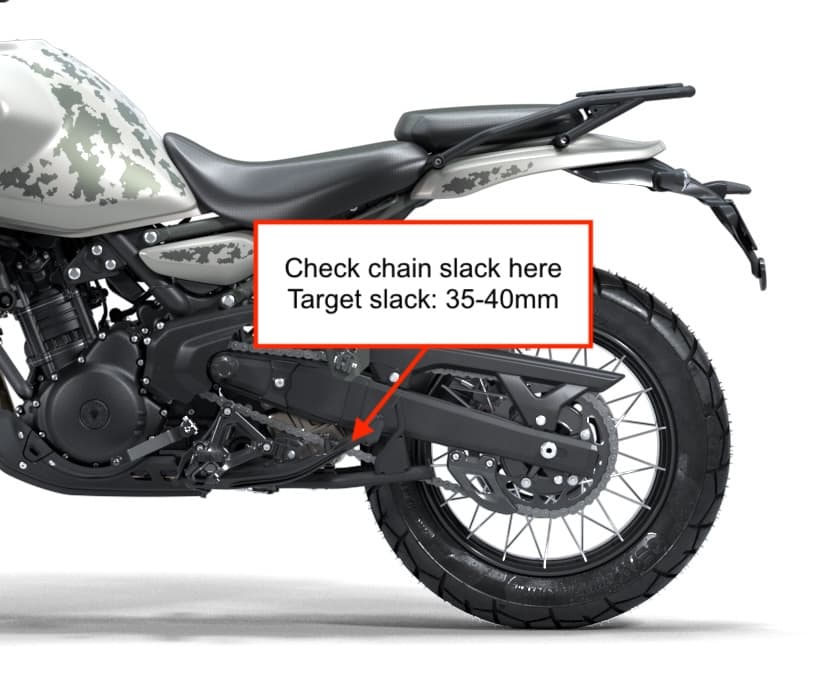
Slack on the Royal Enfield Himalayan is defined as the free vertical play of the chain. Push the chain up and measure the distance to the swing arm, and then push it downwards and make the same measurement. The chain slack is the difference between the two.
Target chain slack for the Royal Enfield Himalayan 450: 35 – 40 mm (1.4 – 1.6 in)
If the chain slack is out of spec, you should adjust it.
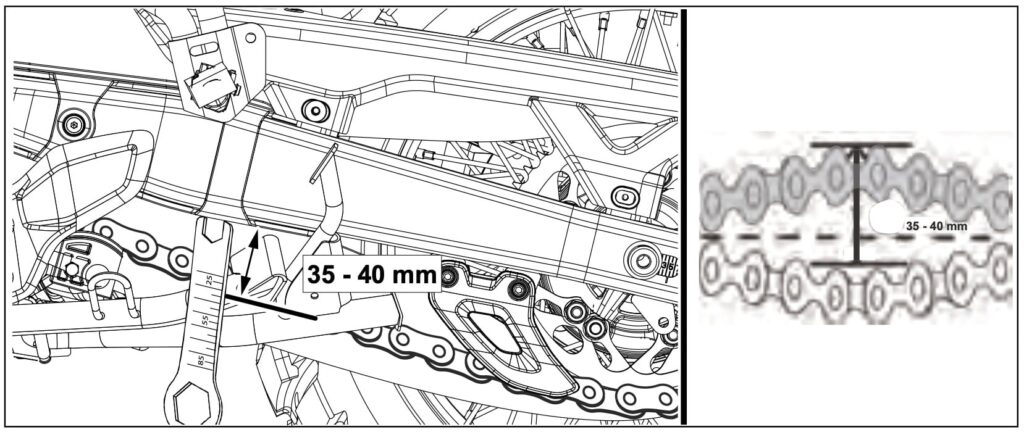
Adjusting chain slack
To adjust the chain slack on the Himalayan 450, follow the steps below. As with measuring chain slack, make sure that the motorcycle is on a level surface on its kickstand, in neutral, with no weight on it (no saddlebags / luggage).
- Loosen the rear axle (you may need a breaker bar) and the adjuster lock nuts on either side of the axle.
- Turn the adjuster nuts to tighten (or loosen) the chain. Keep checking the chain tension to see if it has come within spec.
- Keep an eye on the adjuster alignment marks on either side of the axle. Make sure that the adjustment is to the same point.
- When you’re done, tighten the axle to 70 Nm / 50 lb-ft.
- Tighten the adjuster lock nuts to 10 Nm / 7 lb-ft.
- Re-check the chain slack again to make sure it’s still within spec.
If you’re unable to get the chain slack within spec (it’s still too loose), it’s likely that the chain is too worn and needs to be replaced, along with the sprockets.
Wheels and Tires
The Royal Enfield Himalayan 450, like its predecessor, has an adventure-ready 21-inch front tire and spoked rims. It ships with tube-type tires.
Below are the tire sizes and recommended tire pressures when cold.
| Wheel | Rim size | Tire size | Tire pressure (cold) |
|---|---|---|---|
| Front | 1.85 x 21 in | 90-90/21 M/C 54H CEAT tube-type | 220 kPa / 32 psi |
| Rear | 3.0 x 17 in | 140/80R17 M/C 69H tube-type | 220 kPa / 32 psi |
About the Royal Enfield Himalayan 450
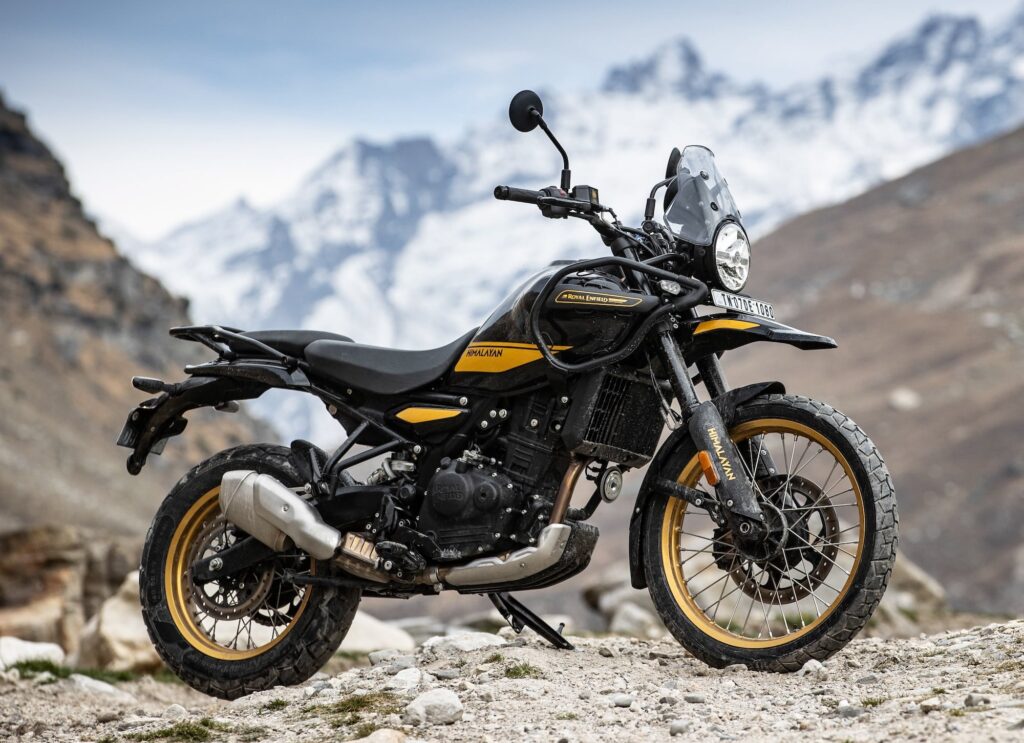
The 2024 Royal Enfield Himalayan 450 is a total overhaul of the Royal Enfield Himalayan, a compact and affordable adventure bike that is very popular for adventure motorcyclists — whether beginners not wanting to over-invest, or more experienced (like those on ADVRider) and wishing to downsize to something simpler and more affordable.
Like its predecessor, the Himalayan 450 is powered by a liquid-cooled single-cylinder engine. But everything about the engine is new. Called the Sherpa 450 (though actually 452 cc), it’s Royal Enfield’s first liquid-cooled engine — ever. Partly driven by emissions laws, the liquid cooling also lets Royal Enfield squeeze quite a lot more power out of the Himalayan 450 — around 60% more!
While the Royal Enfield Himalayan 450 is no powerhouse, its 24 kW / 40 peak horsepower at 8500 rpm is at least no longer anaemic. The new bike also gets a six-speed transmission. Welcome to the future!
The bike still has a manageable size, with an adjustable seat height ranging from 31.7 to 32.5 inches. For adventure bikes, this is relatively low. The wet weight is claimed to be around 196 kg / 432 lbs. While no lightweight dirt bike, this is at least under the 200 kg mark. The bike’s design tilts the engine forward, altering the weight bias towards the front, and includes a dry sump for increased ground clearance.
Royal Enfield has started adding more tech to its motorcycles. The Himalayan 450 has not just switchable ABS, but two ride modes via ride-by-wire! It’s debatable whether ride modes are necessary on a low-power bike, but the “Eco” ride mode lets you opt into using even less fuel to get you more range. With over 250 miles / 400 km of range, the Himalayan is designed to last a long time between fuel stops.
Royal Enfield also significantly updated the display. It still is a blend of old and new, being a TFT display but in round format, with optional analogue-esque riding layout. But the best part is that the maps engine is now powered by Google Maps!
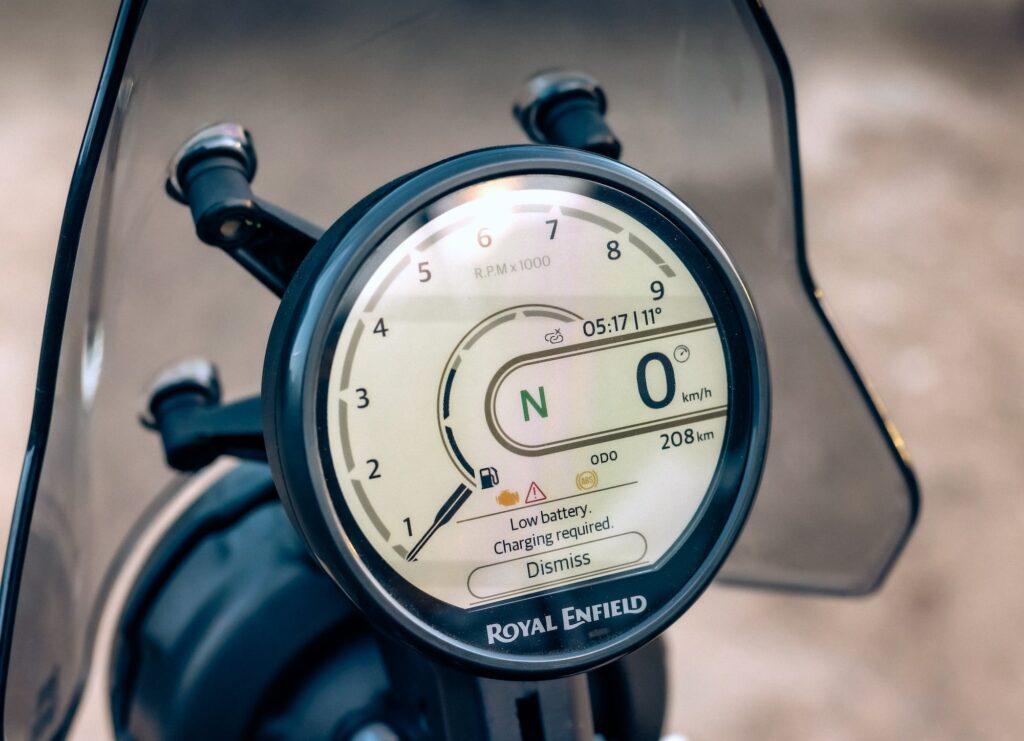
In terms of visual design, Royal Enfield dramatically changed how the Himalayan appears. The 2024 Himalayan 450 departs from the utilitarian look of its predecessor, adopting a more modern and slightly bulbous design, particularly noticeable in the fuel tank. It’s still rugged and adventure-ready, but lacks the unique style of its predecessor. Still, it’s a good-looking machine.
The maintenance requirements for the engine of the Himalayan 450 may be where it’s most distinct from its predecessor.
The original Himalayan, with the air-cooled LS410 engine, had 3,000 mile / 5,000 km valve service intervals — super short. But the job was easy. It only had two valves, and the screw-and-locknut valve design meant that adjustments could be done on the side of the road with few tools, if needed.
The new Himalayan 450, however, has four shim-under-bucket valves, which are harder to service — you have to remove the camshafts and have spare shims on hand. But the upside is that valve service intervals are much wider, particularly after the first two valve services.
The new Royal Enfield Himalayan 450 is a huge improvement over the old Himalayan in many ways. The original Himalayan set the tone for a basic adventure bike, and the new one still has little to no competition in the segment. So it remains to be seen whether it can continue to own the segment of lightweight adventure motorcycles.
No, the new Himalayan still doesn’t have cruise control. But something like a Go Cruise 2 throttle lock can go a long way.
While the original Himalayan was launched to a market with very little competition, the Himalayan 450 arrives roughly at the same time as another compact adventurer, the CFMOTO 450MT, which will be sure to provide interesting competition.
Reference — Manual Screenshots
The above info came mostly from the manual for the Royal Enfield Himalayan 450. If you have a VIN, you can download the manual for your model from the official site.
